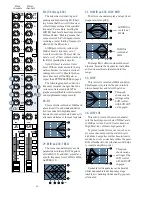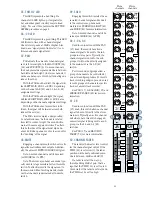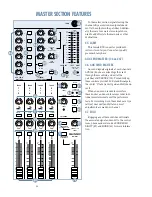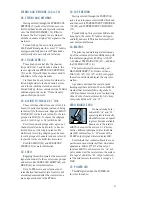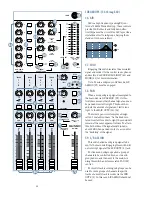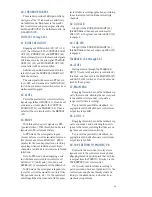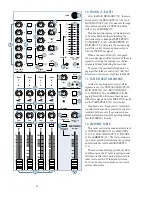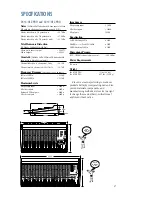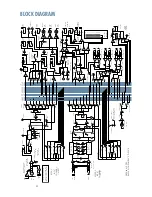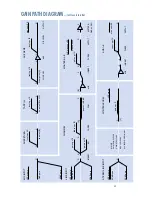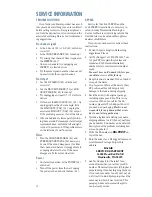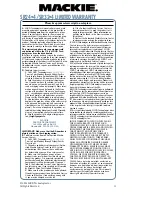
21
35. THIS OL’ LED
This LED represents a bad thing: If a
channel’s OL LED lights up, its signal is too
hot, and subsequent circuitry may overload
(clip). To correct this, perform the SET THE
LEVELS procedure on page 8.
36. -20 LED
This LED represents a good thing: This LED
will flicker in time with a channel’s signal
when its level peaks at -20dB or higher. Also
known as a “signal present indicator,” it con-
firms an adequate signal level.
37. PAN
PAN adjusts the amount of channel signal
sent, left versus right, to the MAIN OUTS (12)
(16) and SUB OUTS (8). On mono channels,
the knob places the signal somewhere between
hard left and hard right. On stereo channels, it
works as a balance control, by attenuating one
side or the other.
With the PAN knob hard left, the signal will
feed LEFT MAIN, SUB 1 or SUB 3, depending
on the channel’s L-R (41) and 1-2 & 3-4 (40)
assignment settings.
With the PAN knob hard right, the signal
will feed RIGHT MAIN, SUB 2 or SUB 4, also
depending on the channel assignment settings.
With the PAN knob set somewhere in be-
tween, the signal will be shared across both
sides of the mix(es).
The PAN circuits employ a design called
“constant loudness.” As the knob is rotated
from left to center to right, the sound will re-
main at the same apparent volume. To attain
this, both sides of the signal must dip down
about 4 dB when panned center, to account for
the “doubling” of the signal.
38. MUTE
Engaging a channel’s mute switch severs its
signal from all subsequent outputs. Addition-
ally, the adjacent MUTE/SOLO LED will glow.
Note: A muted channel can still be soloed
(set MODE (63) to PFL).
Note: The mixer’s pre-fader aux sends, typi-
cally used for stage monitors, follow this mute
switch. To effectively mute the signal sent to
the main mix without muting monitor feeds,
use that channel’s fader instead of the mute
switch.
39. SOLO
Engaging this switch isolates the as-
sociated channel’s signal and sends it
to the control room, phones and
meters. See RUDE SOLO LIGHT (61)
and MODE (63) for more information.
Note: A muted channel can still be
soloed (set MODE (63) to PFL).
40. 1-2 & 3-4
Used in conjunction with the PAN
(37) knob, these switches allow a
channel signal to be sent to the sub-
groups in stereo pairs. Typically, if a
channel signal is routed to the sub-
groups, it will not be directly assigned
to the main mix via the L-R (41)
switch.
For live sound, subgroups allow a
group of channels to be controlled by
one or two subgroup faders. For multi-
track recording, subgroups can be used
to route groups of channels to specific
tracks of a multi-track recorder.
See PAN (37), L/R ASSIGN (59) and
SUBGROUP FADER (60) for more in-
formation.
41. L-R
Used in conjunction with the PAN
(37) knob, this switch allows a channel
signal to be sent directly to the stereo
main mix. Typically, an active channel
will always have this switch engaged,
unless its signal is being sent to a sub-
group, via the 1-2 and 3-4 (40)
switches.
See PAN (37) and MAIN MIX
FADER (72) for more information.
42. CHANNEL FADER
The fader is the master level control
for the channel’s signal output. If the
TRIM (25) is set correctly, the fader
position will be best positioned some-
where between -20dB and 0dB (U).
If a fader is set all the way up,
thereby adding 10dB of gain, that’s a
sign that the TRIM (25) is set too low.
Conversely, if the fader is set way down,
the TRIM may be set too high.
dB
30
20
10
O
O
40
50
5
5
U
60
10
dB
30
20
10
O
O
40
50
5
5
U
60
10
L
R
L
R
U
O
O
+15
U
O
O
+15
U
O
O
+15
U
O
O
+15
U
+15
-15
U
+15
-15
U
+15
-15
U
+15
-15
U
+15
-15
U
+15
-15
U
+15
-15
U
O
O
+15
U
O
O
+15
U
O
O
+15
U
O
O
+15
U
O
O
+15
U
O
O
+15
U
O
O
+15
U
O
O
+15
-20
+20
U
POST
POST
POST
POST
+15dB
-
45dB
MI
C GAIN
0
U
60
-
10dBV
600
1.5k
150
8k
100
12k
HI
3k
MID
HI
800Hz
MID
LOW
EQ
LOW CUT
75 Hz
18dB/OCT
80Hz
LOW
80Hz
LOW
3-4
L-R
1-2
3-4
L-R
1-2
-20
OL
-20
OL
PRE
1
PRE
PRE
2
3
5
6
12k
HI
MID
FREQ
TRIM
20
TRIM
21
22
AUX
PRE
1
PRE
PRE
2
3
5
6
AUX
20
MUTE
EQ
21 22
MUTE
SOLO
SOLO
PAN
PAN
4
4
MUTE /
SOLO
MUTE /
SOLO
MUTE /
SOLO
MUTE /
SOLO
Mono
channels
Stereo
channels














